Subscribe to our ▶️ YouTube channel 🔴 for the latest videos, updates, and tips.
Perimeter and Area of Trapezium
Here we will discuss about the perimeter and area of a trapezium and some of its geometrical properties.
Area of a trapezium (A) = \(\frac{1}{2}\) (sum of parallel sides) × height
= \(\frac{1}{2}\) (a + b) × h
Perimeter of a trapezium (P) = sum of parallel sides + sum of oblique sides
Some geometrical properties of a trapezium:
In a trapezium PQRS in which sides PQ and RS are parallel, and X and Y are respectively the middle points of PS and QR,
XY = \(\frac{1}{2}\) (PQ + SR)
Area of ∆QSR = area of ∆PSR
Area of ∆PQS = area of ∆PQR
Solved example problem on finding the perimeter and area of a trapezium:
1. In the trapezium PQRS, PQ ∥ RS and ∠PSR = 90°. If PQ = 15 cm, SR = 40 cm and the diagonal PR = 41 cm then find the area of a trapezium.
Solution:
In the right-angled ∆PSR,
PR\(^{2}\) = PS\(^{2}\) + SR\(^{2}\)
Therefore, 41\(^{2}\) cm \(^{2}\) = PS\(^{2}\) + 40\(^{2}\) cm\(^{2}\)
⟹ PS\(^{2}\) = (41\(^{2}\) - 40\(^{2}\)) cm\(^{2}\)
= (41 + 40) (41 – 40) cm\(^{2}\)
= 81 × 1 cm\(^{2}\)
= 81 cm\(^{2}\)
Therefore, PS = 9 cm
Therefore, area of the trapezium PQRS = \(\frac{1}{2}\) (sum of the parallel sides) × height
= \(\frac{1}{2}\) (PQ + SR) × PS
= \(\frac{1}{2}\) (15 + 40) × 9 cm\(^{2}\)
= \(\frac{1}{2}\) × 55 × 9 cm\(^{2}\)
= \(\frac{495}{2}\) cm\(^{2}\)
= 247.5 cm\(^{2}\)
2. The parallel sides of a trapezium measure 46 cm and 25 cm. Its other sides are 20 cm and 13 cm. Find the distance between the parallel sides and the area of the trapezium.
Solution:
PQRS is a trapezium in which RS ∥PQ, RS = 25 cm and PQ = 46 cm.
Also, PS = 20 cm and QR = 13 cm
Draw RT ∥ SP and RU ⊥ PQ
Then RSPT is a parallelogram.
So, RT = SP = 20 cm and PT = SR = 25 cm
Therefore, TQ = PQ – PT = 46 cm – 25 cm = 21 cm
Area of the ∆RTQ = \(\sqrt{s(s - a)(s - b)(s - c)}\)
where s = \(\frac{\textrm{RT + TQ + QR}}{2}\)
= \(\frac{\textrm{20 + 21 + 13}}{2}\) cm
= 27 cm
Now, plug the values in \(\sqrt{s(s - a)(s - b)(s - c)}\).
= \(\sqrt{27(27 - 20)(27 - 21)(27 - 13)}\) cm\(^{2}\)
= \(\sqrt{27 ∙ 7 ∙ 6 ∙ 14}\) cm\(^{2}\)
= \(\sqrt{3 ∙ 3 ∙ 3 ∙ 7 ∙ 3 ∙ 2 ∙ 7 ∙ 2}\) cm\(^{2}\)
= \(\sqrt{3^{2} ∙ 3^{2} ∙ 7^{2} ∙ 2^{2}}\) cm\(^{2}\)
= 3 ∙ 3 ∙ 7 ∙ 2 cm\(^{2}\)
= 126 cm\(^{2}\)
Also, the area of the ∆RTQ = \(\frac{1}{2}\) TQ × RU = \(\frac{1}{2}\) × 21 cm × RU cm\(^{2}\)
Therefore, 126 cm\(^{2}\) = \(\frac{1}{2}\) × 21 cm × RU
or, RU = \(\frac{126 × 2}{21}\) cm
or, RU = 12 cm
Therefore, the distance between the parallel sides = 12 cm
Therefore, area of the trapezium PQRS = \(\frac{1}{2}\) × (SR + PQ) × RU
= \(\frac{1}{2}\) × (25 + 46) × 12 cm\(^{2}\)
= \(\frac{1}{2}\) × (25 + 46) × 12 cm\(^{2}\)
= \(\frac{1}{2}\) × 71 × 12 cm\(^{2}\)
= \(\frac{852}{2}\) cm\(^{2}\)
= 426 cm\(^{2}\)
Application on Perimeter and Area of Trapezium:
3. The shape of the cross section of a canal is a trapezium. If the canal is 10 m wide on the top and 6 m wide at the bottom, and the area of its cross section is 72 m2 then find the depth of the canal.
Solution:
The cross section is the trapezium PQRS in which PQ ∥ RS. Here PQ = 10 m, RS = 6 m, and area of the trapezium PQRS = 72 m2.
Let d be the depth of the canal.
Then, area of the trapezium PQRS = \(\frac{1}{2}\)(PQ + RS)d
⟹ 72 m2 = \(\frac{1}{2}\)(10 + 6) × d
⟹ d = \(\frac{72 × 2}{16}\) m = 9 m
Therefore, the depth of the canal = 9 m.
From Perimeter and Area of Trapezium to HOME PAGE
Didn't find what you were looking for? Or want to know more information about Math Only Math. Use this Google Search to find what you need.
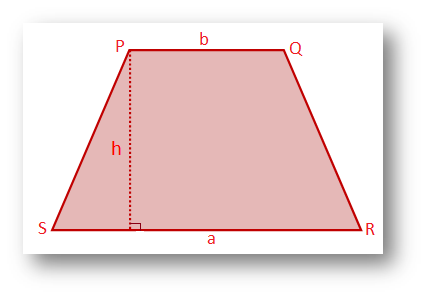
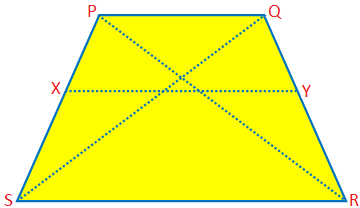
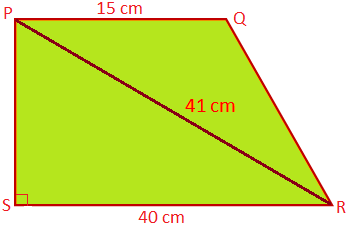
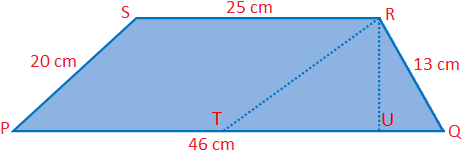
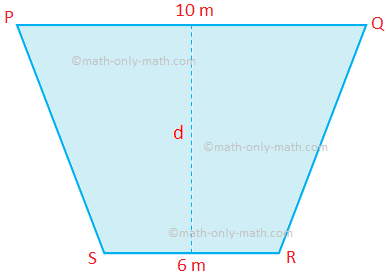


New! Comments
Have your say about what you just read! Leave me a comment in the box below. Ask a Question or Answer a Question.